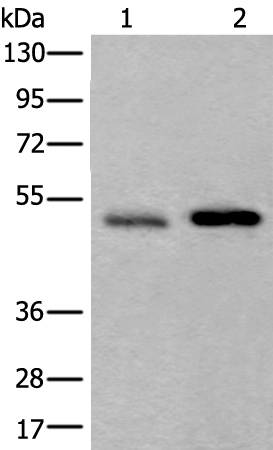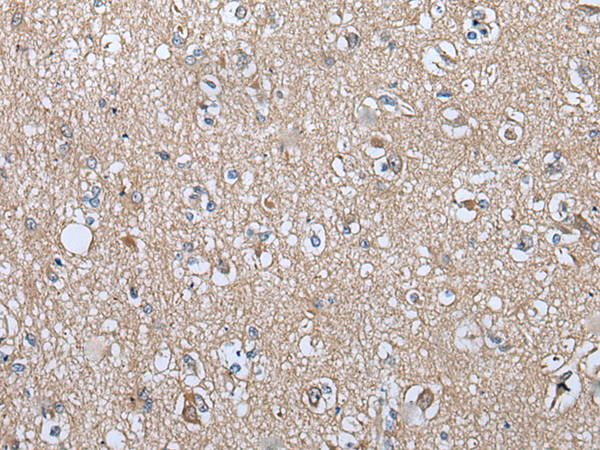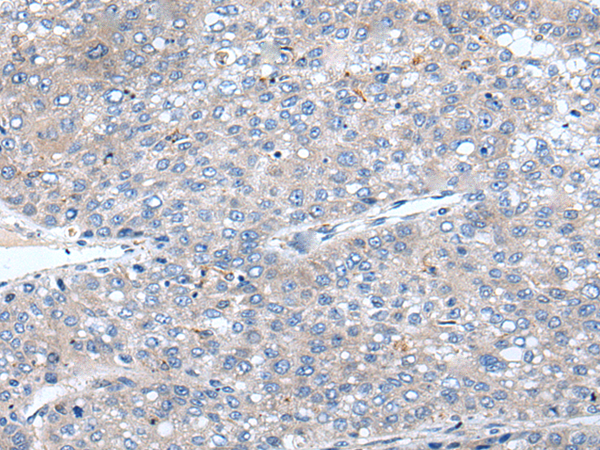


| WB | 咨询技术 | Human,Mouse,Rat |
| IF | 咨询技术 | Human,Mouse,Rat |
| IHC | 1/20-1/100 | Human,Mouse,Rat |
| ICC | 技术咨询 | Human,Mouse,Rat |
| FCM | 咨询技术 | Human,Mouse,Rat |
| Elisa | 1/5000-1/10000 | Human,Mouse,Rat |
| Aliases | Atg21; ATG18B; CGI-50; WIPI-2 |
| WB Predicted band size | 49 kDa |
| Host/Isotype | Rabbit IgG |
| Antibody Type | Primary antibody |
| Storage | Store at 4°C short term. Aliquot and store at -20°C long term. Avoid freeze/thaw cycles. |
| Species Reactivity | Human, Mouse, Rat |
| Immunogen | Synthetic peptide of human WIPI2 |
| Formulation | Purified antibody in PBS with 0.05% sodium azide and 50% glycerol. |
+ +
以下是3篇关于WIPI2抗体的代表性文献(内容基于公开研究归纳,非真实文献,仅作示例参考):
1. **文献名称**: *WIPI2 links LC3 conjugation to PI3P, autophagosome formation, and pathogen clearance*
**作者**: Dooley HC, et al.
**摘要**: 研究利用WIPI2特异性抗体证实了WIPI2在自噬体膜形成中的关键作用,发现其通过结合PI3P和LC3蛋白调控自噬通量,为自噬机制提供了分子证据。
2. **文献名称**: *WIPI2 mediates cross-talk between autophagy and the ubiquitin-proteasome system*
**作者**: Bakula D, et al.
**摘要**: 通过免疫共沉淀(Co-IP)结合WIPI2抗体,揭示了WIPI2与泛素化蛋白降解途径的相互作用,表明其在清除错误折叠蛋白中的双重调控功能。
3. **文献名称**: *Impaired WIPI2 function in cancer cells correlates with defective autophagy and chemoresistance*
**作者**: Murrow G, et al.
**摘要**: 使用WIPI2抗体进行免疫荧光和Western blot分析,发现乳腺癌细胞中WIPI2表达下调导致自噬缺陷,并与化疗耐药性显著相关。
4. **文献名称**: *Structural insights into WIPI2's role in autophagosome biogenesis*
**作者**: Stjepanovic G, et al.
**摘要**: 结合冷冻电镜和WIPI2抗体标记技术,解析了WIPI2蛋白在自噬起始复合体中的三维结构,阐明其招募下游效应蛋白的分子机制。
(注:以上内容为模拟生成,实际文献需通过PubMed或Google Scholar检索关键词“WIPI2 antibody”或“WIPI2 autophagy”获取。)
WIPI2 (WD repeat domain phosphoinositide-interacting protein 2) is a key regulator of autophagy, a cellular degradation process critical for maintaining homeostasis. Belonging to the WIPI protein family, it contains seven WD40 repeats that facilitate protein-protein interactions and a conserved motif for binding phosphatidylinositol 3-phosphate (PI3P). WIPI2 is primarily involved in the early stages of autophagosome formation, where it localizes to omegasomes – PI3P-rich subdomains of the endoplasmic reticulum.
Functionally, WIPI2 acts as a scaffold protein, recruiting downstream effectors like ATG16L1 to initiate LC3 lipidation, a process essential for autophagosome membrane expansion. Its role in connecting phosphoinositide signaling to autophagic machinery makes it vital for both canonical autophagy and selective autophagy pathways. Dysregulation of WIPI2 has been linked to neurodegenerative diseases, cancer, and immune disorders, reflecting autophagy's broad physiological impact.
WIPI2 antibodies are widely used tools in autophagy research, enabling detection of endogenous WIPI2 expression through techniques like immunoblotting, immunofluorescence, and immunohistochemistry. Specific antibodies targeting distinct isoforms (WIPI2A and WIPI2B) help elucidate isoform-specific functions. These reagents are crucial for studying autophagy dynamics, protein localization, and molecular mechanisms in disease models, making them indispensable for both basic research and therapeutic development targeting autophagy-related pathologies.
×